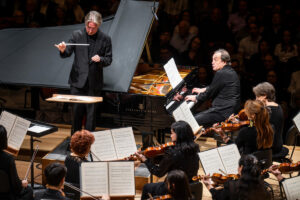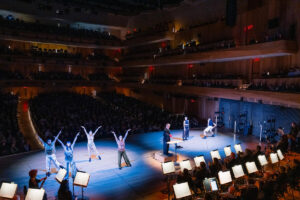Salonen Conducts New York Philharmonic (Concert Review)

The NY Philharmonic Celebrates Boulez’s Centenary
Works by Bartók, Boulez, Debussy, and Stravinsky
Pierre-Laurent Aimard, piano
New York Philharmonic, Esa-Pekka Salonen, conductor
Saturday, October 4, 2025
Saturday, October 11, 2025
NEW YORK – In October, Esa-Pekka Salonen conducted the New York Philharmonic for two consecutive weeks. Both programs celebrated the centenary of the composer and conductor Pierre Boulez (1925-2016), who was Music Director of the New York Philharmonic from 1971-1977. Boulez was a key figure of the post-WWII avant-garde and a proponent of serial music, then in its early stages. By the 1970s, Boulez was an internationally renowned conductor of a wide range of repertoire, and his time with the NY Phil was distinguished by a high level of music-making. Still, his advocacy for increasing the number of contemporary works presented was not welcome in all corners. Balancing the programming of repertory staples with that of twentieth and twenty-first century music remains a much-debated topic at the NY Phil, both within the organization and among its listeners. This is true of most American orchestras, and had more than a bit to do with Salonen’s recent decision to end his directorship of the San Francisco Symphony. Thus, it was heartening to see Boulez’s music received so well by the audiences at well-attended concerts on October 4th and 11th.
Claude Debussy (1862-1918) was the other composer on the first concert, and it was a simpatico pairing. Boulez admired Debussy and frequently performed his music. In the concert’s first half, works by the two composers alternated. Debussy was represented by movements from the orchestral version of Images, which shared a point of inception with the programmed Boulez pieces: they are transcriptions of piano pieces. In the 1940s, Boulez wrote twelve piano miniatures called Notations, each twelve measures long but varied in tempo and character to create a group of pieces that helped prove his avant-garde bona fides. In succeeding decades, Boulez returned to some of them and remade them for orchestra. Three of these, in both their original and orchestrated forms, were performed. Pierre-Laurent Aimard played the movements from Notations in authoritative fashion, scrupulously observing the tempos conceived for their solo renditions. Frequently the orchestral version has been written to be played a bit more slowly, for the purposes of resonance and ensemble coordination; the latter at times is formidably challenging. It is to the NY Phil’s credit that their playing took into account the disparate nature of all the music in the first half, rendering each inflection, some quite nuanced, with sensitivity. Salonen abetted this effort with a clear approach that embodied the scores in a manner not dissimilar to Boulez’s conducting style.
Aimard would later be the piano soloist in Fantasie, an infrequently performed early piece by Debussy, started during his Prix de Rome days and only published posthumously. It is not one of Debussy’s finest pieces, and its spate of revisions shows seams in a number of places, sounding like a grand tour of the stylistic evolution throughout his career. The piano part is virtuosic, sometimes stepping into the spotlight and at others blending in with the orchestra in a demonstration of esprit de corps. If anyone can make Fantasie at all compelling it is Aimard, who distinguished himself with fleet-fingered runs and thoughtful turns of phrase.
Debussy’s La Mer, his beloved orchestral work, was the program’s finale. Water’s motion, environs, and the denizens dependent upon it are frequent touchstones for the composer, nowhere more so than here, although the grotto scene from his opera Pelleas et Melisande is a strong contender. The piece has had a somewhat quixotic afterlife as a shorthand trope for the sea in many films, from documentaries to Hollywood blockbusters. The real thing still trumps all of them. The NY Philharmonic played it pristinely under Salonen’s direction.

The concert on October 11th featured two more composers in Boulez’s orbit: Béla Bartók (1881-1945) and Igor Stravinsky (1882-1971). The latter was represented by his Octet for Winds, a piece firmly rooted in the neoclassical tradition that pits a woodwind quartet of flute, clarinet, and two bassoons against two trumpets and two trombones. The music is filled with contrapuntal assertions and responses between winds and brass. This heterodox ensemble is difficult to balance and wasn’t perfect in this respect here, and the position of the group didn’t seem to be in an acoustically ideal spot onstage. Still, the interplay between performers was impressive.
Bartók’s Concerto for Orchestra is among the masterpieces of the past century. Like the octet, it is filled with counterpoint, including some of the fugal variety. Both Stravinsky and Bartók were able to navigate the delicate balance between music of the past and innovation. In addition to baroque music, Bartók references folk music from Eastern Europe. There is also a jocular trope on a theme by Dmitri Shostakovich (1906-1975), poking fun at his Russian counterpart for toeing the cultural lines drawn by Stalin. Not the first concerto for orchestra, in which each section gets an opportunity to be highlighted, it remains the best yet composed. The NY Phil, especially with the dynamic gestures of Salonen, played it like few other orchestras can dream to match.
In the performance’s second half, a more extensive work than Notations was presented. Rituel in memoriam Bruno Maderna was composed in 1975, while Boulez was still conducting the NY Phil. Maderna was a close associate, and his death from lung cancer at 53 was a difficult loss to contemplate. Although its use of gongs and chorale-like chords in the brass is evocative of ceremony, Rituel does not explicitly reference any religious traditions. Rather, it is a postmodern, secular type of valediction, in which spatial deployment envelops the audience in a solemn, eloquent meditation on grief. With a cohort onstage, other members of the orchestra were arrayed throughout the hall, their parts reverberating in well-coordinated fashion. There is a plethora of percussion instruments, with the players deployed in an additive fashion, with each of Rituel’s eight sections supplying more percussionists. This was also true of the other players in the other sections of the orchestra, supporting a long, powerful crescendo, one that then subsides in a gradual denouement.
The LA Dance Project was on hand for Rituel, performing onstage in front of, and sometimes between, members of the orchestra. It featured six dancers, two principals who wore black and four others in various shades of color. The choreography captured both fluid musical lines and percussive gestures, representing the stages of grief encountered after a loss in a dance that was modern in character and well-executed. Given Maderna’s death after an illness, the physicalization of violence, with both symbolic crucifixion and stabbing, seemed in places more like Sacre du Printemps than the demeanor of Rituel. Still, it added a layer of emotionality to a compelling use of the entirety of Geffen Hall. One hopes that more spatial music is on offer in the future, and that Salonen remains a frequent visitor to New York to perform with the orchestra.
-Christian Carey